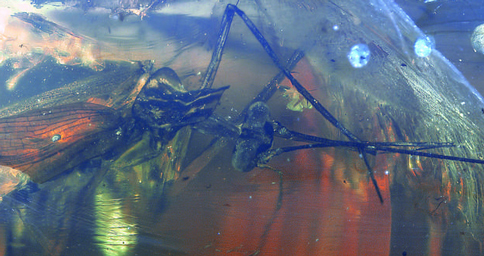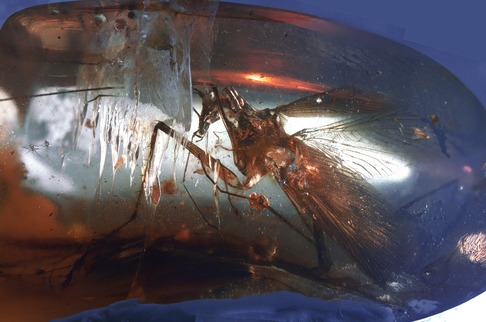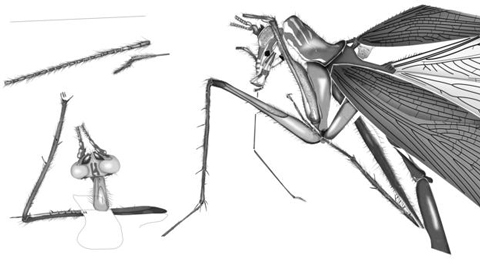Cretaceous Cockroach – A Deadly Night Time Predator
Predatory Cockroach Manipulator modificaputis – An Insect Chimera from the Cretaceous
Stalking the forest floor, most probably in the dead of night around 97 million years ago, was a little Cretaceous critter, a predatory cockroach that possessed a range of characteristics making it look like an insect chimera. At around one centimetre in length, it was not going to break any records for size but with its triangular shaped head, elongated legs and mouthparts it would have been a formidable hunter of other nocturnal arthropods.
Preserved in Amber
The fossilised remains of this insect, a new species, were found in a piece of amber collected from a mine in Noije Bum, northern Myanmar (Burma). It had a narrow body resembling that of an extant Crane fly, graceful wings and it grasped prey using its modified front legs that were covered in short, strong spines. The insect has been named Manipulator modificaputis, placed in a new family of extinct cockroaches (the Manipulatoridae) and it represents the first cockroach family to be reported exclusively from Burmese amber.
A Fearsome Night Time Predator of the Late Cretaceous
Picture credit: Peter Vršanský
Cretaceous Cockroach
Peter Vršanský (Geological Institute in Bratislava, Slovakia), along with co-author Günter Bechly (The Staatliches Museum für Naturkunde Stuttgart), have produced a paper on this new discovery. The paper has been published in the academic journal “Geologica Carpathica”. Readers of this blog may recognise the Stuttgart Museum as being the institution that co-operates with the German figure manufacturer Bullyland to make their museum line prehistoric animal models.
To view the Bullyland range of dinosaur and prehistoric animal models: Bullyland Models and Figures.
A Close Up View of the Predatory Insect

Preserved in amber. The delicate wings, long neck, large eyes and modified mouthparts can be clearly made out in this dorsal view (top down) of the specimen.
Picture credit: Peter Vršanský
The Insecta Order Radiates
During the Cretaceous there was an extensive radiation of the Insecta Order. Many new families evolved to take advantage in fundamental changes in flora as the angiosperms (flowering plants) evolved and became the dominant land plants. During this geological period, several different types of predatory cockroach-like lineages evolved, but only one Order survives today – the Mantodea (the Mantises). The scientists conclude that this insect was probably not a direct ancestor of the Praying Mantis, but that it probably represents a early side branch of the stem group that makes up the first of the Mantodea.
An Exquisite Line Drawing of the Fossil Material
Picture credit: Peter Vršanský
More Specimens Reported
A further four specimens have been reported including an immature individual. These specimens are just a few of the dozens of preserved insect remains that have been preserved in amber found in this part of Asia. Dr Vršanský commented that the Noije Bum area, of northern Myanmar is the most important site of dinosaur-age amber in the world. Many amber pieces contain complete adult insects, this fossil evidence is providing scientists with extensive information about some of the smaller creatures that inhabited terrestrial, arboreal environments that were dominated by the Dinosauria.
The etymology of the name Manipulator modificaputis alludes to the extremely long extremities that this insect possessed. These were used to capture, hold and manipulate prey. The large eyes which gave this little insect excellent vision would have helped it to spot predators, after all, it would have made a tasty snack for a small dinosaur on a night time patrol.



